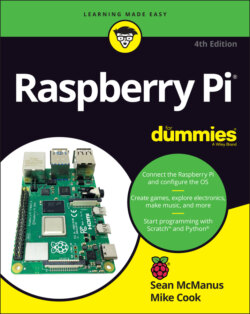Читать книгу Raspberry Pi For Dummies - McManus Sean, Evans Jonathan, Sean McManus - Страница 71
Backing Up Your Data
ОглавлениеIf you want to back up your files, you can easily copy them to a USB key using File Manager as described earlier in this chapter, or using shell commands. (See Chapter 5 on file copying, and the Appendix for more on mounting external storage devices.) If you’ve got a lot of files on the MicroSD card, though, and you’ve spent time customizing it with your preferred settings and software, you might prefer to make a backup copy of the entire card. There’s an application to do this, called SD Card Copier, which you can find in the Accessories section of the Applications menu.
To use SD Card Copier effectively, you need a USB MicroSD card reader, which will enable you to read and write additional MicroSD cards from your Raspberry Pi, using a device plugged into one of the USB ports. If you don’t have a MicroSD card reader, you can use the application to back up to a USB flash drive; you would need a card reader, though, to restore the backup to a MicroSD card so that you can use it in your Raspberry Pi.
The MicroSD card or the USB key that you back up to will be totally erased. Ensure that there’s nothing on it you need before you begin.
The application is shown in Figure 4-12. It has two menus, where you choose which device to copy from and which device to copy to. If you’re not sure which MicroSD card contains your operating system (the one the Pi is currently using), check the Copy To Device menu: It won’t be listed there, because you can’t use this application to write to the card the Raspberry Pi is using for its operating system.
Raspberry Pi Foundation
FIGURE 4-12: The SD Card Copier application.
The backup might take some time, during which it can look like nothing’s happening, so be patient.
